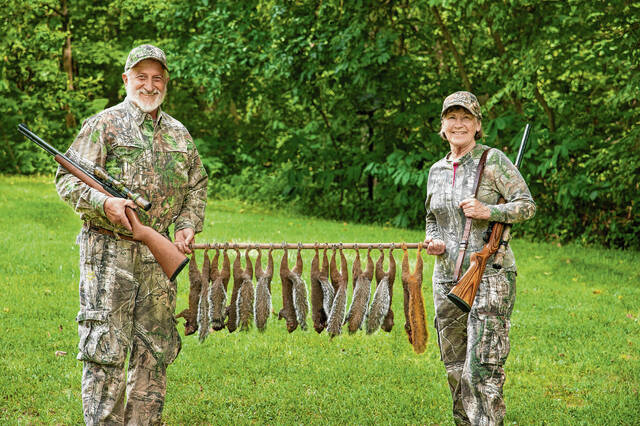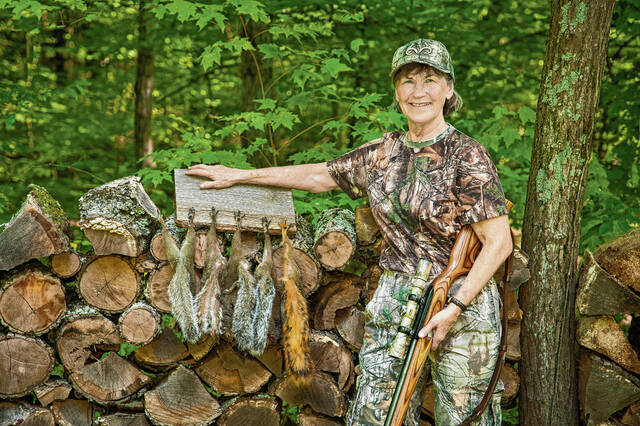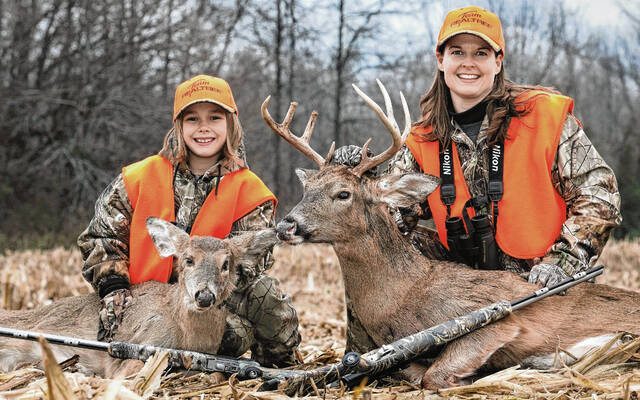
Shannon Winks of Vallonia, who is a public lands biologist at Starve Hollow State Recreation Area, took up hunting in the 1990s and also bonded with her daughter, Emma, through hunting.
Courtesy of Shannon Winks
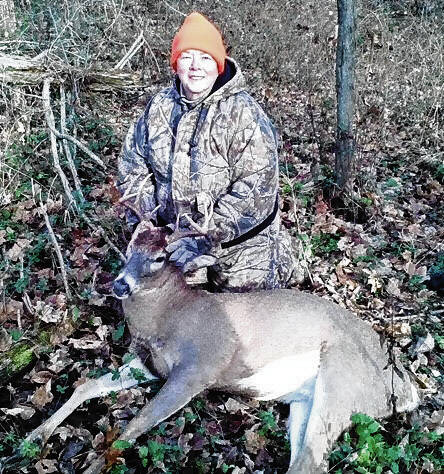
Dixie Pruitt, 78, of Seymour is a longtime hunter, though she was in her 30s before going hunting with her late husband.
Courtesy of Dixie Pruitt
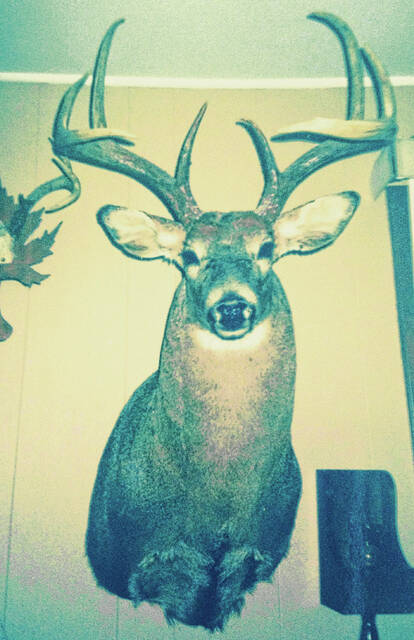
Dixie Pruitt of Seymour is proud of this deer mount that once hung on the wall at her home.
Courtesy of Dixie Pruitt
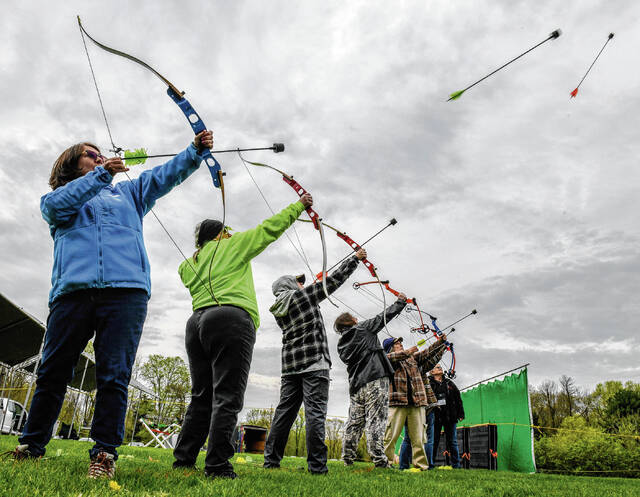
Women attending an Indiana Department of Natural Resources Becoming an Outdoors Woman program learn the fundamentals of archery.
Courtesy of Indiana Department of Natural Resources
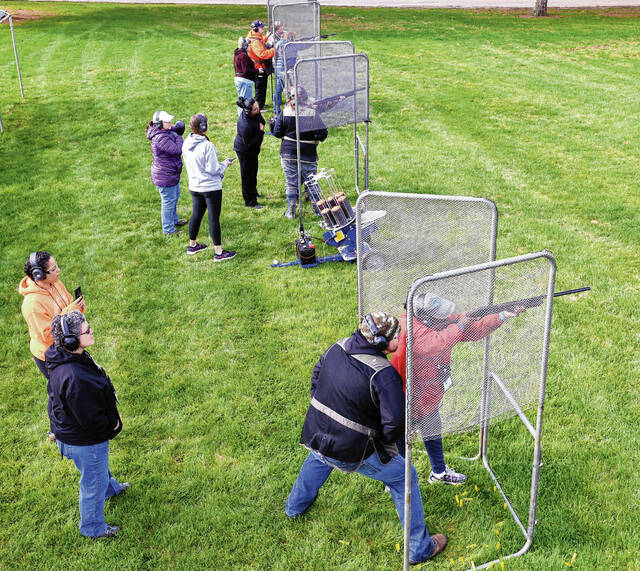
Among the subjects taught at an Indiana Department of Natural Resources Becoming an Outdoors Woman program is proper shooting techniques.
Courtesy of Indiana Department of Natural Resources
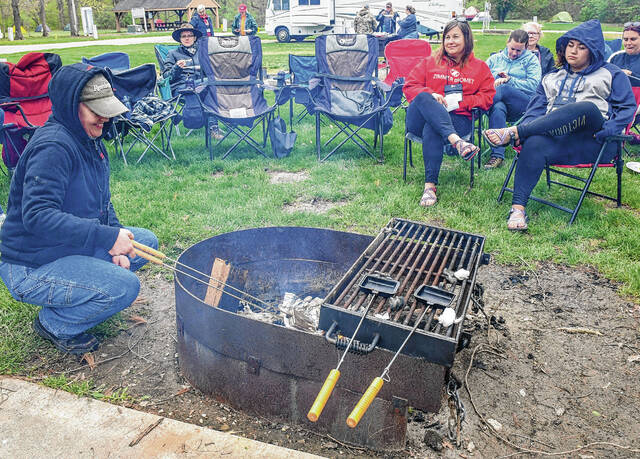
After learning the finer points of harvesting wild game, women enrolled in the Indiana Department of Natural Resources Becoming an Outdoors Woman program learn how to cook in the outdoors.
Courtesy of Indiana Department of Natural Resources
The first deer Shannon Winks harvested was a four-point buck when she shot her arrow 25 yards as accurately as William Tell.
“I was ecstatic,” said Winks, 48, who was left out of family hunting trips growing up because she was a girl. “It was a very strong adrenaline rush.”
Now a private lands biologist for the Department of Natural Resources’ Division of Fish Wildlife in Vallonia, Winks’ situation was commonplace in Indiana and around the United States in the past. Hunting was a guy thing, and women who hunted were an exception.
“I was never asked if I was interested,” Winks said when her father and brother took hunting trips. “There was not a lot of women hunting at the that time that I knew.”
No longer true. One way that hunting is different in the 21st century is the increase in the number of women who have embraced hunting, who hunt for food and the experience in the wild.
“I basically fill the table,” said Winks, who lives in the Tampico area. “I love to eat venison.”
Indiana statistics dating to 2005 show a steady growth in the number of women hunting. That year, women represented 4% of licensed Hoosier hunters. By 2020, the share had expanded to 9%.
In pure numbers, 8,713 Indiana women bought some type of hunting license in 2005, plus another 1,993 paid for combination hunting and fishing licenses. In 2020, the totals were 17,862 and 6,802.
The jump represented licenses for deer, game birds, turkeys, water fowl and of hunting and fishing combo licenses.
“There has been an increase in all of them,” said Linnea Petercheff of the Division of Fish Wildlife.
Winks became interested in archery while attending Purdue University. She said when young, she rode horses and camped, but that was different.
“Mine was the interest in nature,” she said. “Then I started bow hunting.”
Later, Winks introduced her daughter, Emma, to hunting. Although she is in college now and doesn’t hunt as much, Emma periodically joins her mother for excursions.
“She might squirrel hunt with me,” Winks said.
More women hunting
Trade associations and government surveys count 15.1 million hunters in the United States as of 2019 with about 11% of them women.
One study suggested as of eight years ago, 1.8 million women hunted nationwide, but five years ago, it was thought the number was 3.3 million.
One study from a few years ago discussed during a panel discussion at a Backcountry Hunters Anglers National Rendezvous, indicated women hunt fewer than five days a year, focus more on hunting deer than other species and hunt more often on private land than public land.
The latter is significant for Indiana. Those who hunt on their own farmland are not required to purchase licenses, Petercheff said, so they are not included in state data.
Petercheff, 36, first shot a firearm in 2007, and it turned her into a hunter after being raised in a non-hunting family. Her first field trip was bird hunting.
“I got several chukars,” she said.
Stacy Keough, a Whitworth University sociology expert, said at that Spokane, Washington, panel, “Women are currently the fastest growing hunting demographic in the country.”
That generally tracks changes in society over the last half-century. Once, it was comparatively rare for women with children in American society to work outside the home. Then they became bigger components in the workforce, fighting against glass ceilings. Then the issue of equal pay for equal work began being addressed. Still, in politics and other endeavors, there are still references to “firsts” by women in their fields.
This also parallels the growth and impact of Title IX for women and girls in sports. Until the early 1970s, females were second-class citizens in the sports world, but advances since have been measured by huge leaps in sheer participation in high schools, game attendance at the top professional and college levels and in equal administrative treatment.
Outdoor industry manufacturers began catering to women and what they perceive as feminine tastes with their products. It is not impossible to find a pink rifle for sale, as one example.
“I think it’s culturally accepted,” said Anthony Barenie, a state DNR Division of Fish Wildlife manager of women hunting. “More women are looking at fun activities ‘that I should participate in.’ I still think the hunting industry needs to do more.”
Women he knows of who hunt have complained about the choices in clothing and size fits. Pink as a symbol of femininity is one thing.
“If people want that, there is nothing wrong with that,” Barenie said, “but they don’t necessarily want to stand out.”
Danielle Shrake, a program director for the DNR law enforcement division, said some Indiana women seeking more opportunities were not part of the hunting demographic before, but that has changed.
“Single mothers were breaking down that barrier,” Shrake said.
Hesitancy to start hunting because they don’t know anyone doing it or don’t have encouragement to join in from husbands or male partners can keep women on the sidelines. There is fear of being judged as beginners who don’t know what they are doing.
The enormously successful Becoming an Outdoors Woman is a remedy. BOW has made a big impact introducing outdoor skills to women and is just as much in demand in Indiana as elsewhere.
An early 1990s study showed women were interested in the outdoors and wished to participate more, but they wanted to avoid a competitive atmosphere and wanted to learn with other women. The first such instructional program was offered at the University of Wisconsin-Stevens Point in 1991, and BOW began in 2007 in Indiana.
The Indiana class put on by the Department of Natural Resources is an annual workshop the first week in May for women 18 and older. It is a challenge to be accepted because of its popularity. Shrake said entry into the BOW workshop is a competitive process, not based on proficiency but based on the speed of applicants’ computer clicking. Registration opens March 1 online.
“It fills within two weeks,” Shrake said. “We have done up to 150 participants, but it is usually 100. Everything is really hands-on.”
Shooting, fishing, archery, survival, safety and other outdoor recreation are all part of the curriculum. Women bring various experience levels and focus desires to the classes.
“It’s helping women become more comfortable and relaxed in the outdoors,” Shrake said. “Camping can be overwhelming if you’re an adult and not done it.”
Many women, seeking to enhance their knowledge, are repeat customers, coming back after one visit if they can get re-registered.
“Every year, about half are returning participants,” Shrake said.
Firearms education and safety are emphasized, and Shrake has watched attitudes change over a two-day period. She has witnessed a woman crying from nerves over the sight of a firearm to by the end of the workshop be comfortable handling it.
“It’s very empowering,” Shrake said.
For the most part, the women want to become capable shooters, not merely learning basics of handling shotguns, rifles and a bow and arrow.
“Especially the women who are going through the shooting classes, they want to hunt,” Shrake said.
The BOW program, Shrake said, is a cornerstone element for getting more women outdoors. Whether matching more men, more women or more youths to activities, however, it is all part of the DNR mission of recruitment and retention in outdoor recreational opportunities.
Some women beat the crowd
Some women who did not travel West by covered wagon did hunt before BOW, though perhaps not as many who were not influenced by fathers or husbands.
Dixie Pruitt of Seymour is 78 and has hunted for many years, just not since she was a girl.
“I married a guy that hunted,” she said of how she began, though even that was not the sole impetus for her start. “I had a friend and she hunted, and I thought, ‘If she can hunt, I can hunt.’”
She doesn’t remember exactly but said she was a beginner in her 30s. Previously, some aspects of hunting did not appeal to her, like predawn rising and thinking it would interfere with raising children.
“I thought, ‘I can’t imagine getting up before daylight and climbing into a tree stand before my kids go to school,’” she said.
When her daughter graduated high school in 1987, Pruitt felt free to hunt with her husband. They had relatives with property in Freetown, and Pruitt began deer hunting. It took a few seasons, but she killed a buck, and that sparked more passion.
“The hunting fever gets in once you kill something,” said Pruitt, who does have some photos of herself as a younger woman in the field. She also had the deer mounted, but it burned in a fire.
She did climb into deer stands, hunted with a shotgun and a bow. She remembers thinking she hit a deer from above, unsure if it was a good shot, then tracking a blood trail. Her husband, Bud Osborne, trembled with excitement for her.
“He said, ‘Wow! That’s pretty exciting,’” Pruitt said. “I didn’t know hunters got buck fever. I felt like crying. Not out of sadness, but it was emotional.”
Initially, Pruitt didn’t enjoy eating venison. A neighbor did the butchering for a few years and it tasted too “wild” for her. But then she developed some recipes, like burger venison with onions and cream of mushroom.
“I wasn’t crazy about it,” she said. “Then I got my own cooking flavoring.”
Pruitt worked for Jackson County Bank for 26 years and used to bring venison in a crockpot to work potluck dinners.
Once, a co-worker said, “I don’t know who made that steak upstairs, but it’s delicious.” When Pruitt told her it was deer, the woman said, “Oh, you shouldn’t have told me what it is.”
Pruitt’s cooking ensnared church friends the same way, telling skeptics, “You’ve just got to try it.” They responded with, “’Oh my gosh, Dixie, it doesn’t taste wild.’ It just tickles me,” she said of those friends.
Another female hunter, a contemporary of Pruitt’s — and a friend — is Carol Herndon, 75, of Brownstown.
Herndon married a hunter, too, Brad, and has hunted for about 35 years now after growing up in a family in which no one hunted. The Herndons are avid squirrel hunters and love eating squirrel meat. Carol is a crack shot who has had superb harvests with daily limits of five.
She was particularly proud, however, of her first deer and pleased to display the kill on the top of the car on the way home.
“It was homely,” she said, “but it was 120 pounds field dressed. That’s a lot of meat, and venison is a popular dish in the Herndons’ house. I had to show it to everybody.”
“Everybody was happy for you,” Brad said of the moment.
Carol said the idea of deer hunting had long attracted her.
“It sounded like a fun thing to do,” she said. “I thought it would be exciting when you got a deer, and it was.”
Sam McIntosh, 30, a nurse, discovered the truth of that, after coming to hunting through competitive shooting sports, including trap shooting, when growing up in Columbus.
“I thought, ‘I can probably hunt, too,’” McIntosh said, and prevailed on her father, Anthony Hicks, to take her out when she was 18.
She married a hunter, and a dozen years later, she is an active pursuer of several species with Matt. McIntosh remembers her first deer with a 30-yard shot on an early morning hunt that reminded her more of winter than fall.
“It was cool, upper 30s,” she said. “I remember being very cold. I wasn’t sure if I hit it. It actually did run. I should have taken more time, and I thought I might have missed.”
Her dad helped her track the animal by its blood trail. It ran about 100 yards before dropping. Then she realized her harvest was real.
“I was just super happy,” McIntosh said. “I am grateful I have that memory.”
There also was pride that she translated her shooting prowess into hunting success — and she could match the boys who went hunting.
“I wanted to prove to myself that I could do what they could do, as well, and maybe even better,” she said.
And that is how she is raising her daughters, Avery, 5, and Gracyn, 4, exposing them to the hunting lifestyle as they grow up in Azalia, feeding them venison and other animals harvested, teaching them to appreciate the outdoors.
“We’re showing them what they can do and giving them that confidence,” McIntosh said.
By providing the same chances the boys get.

